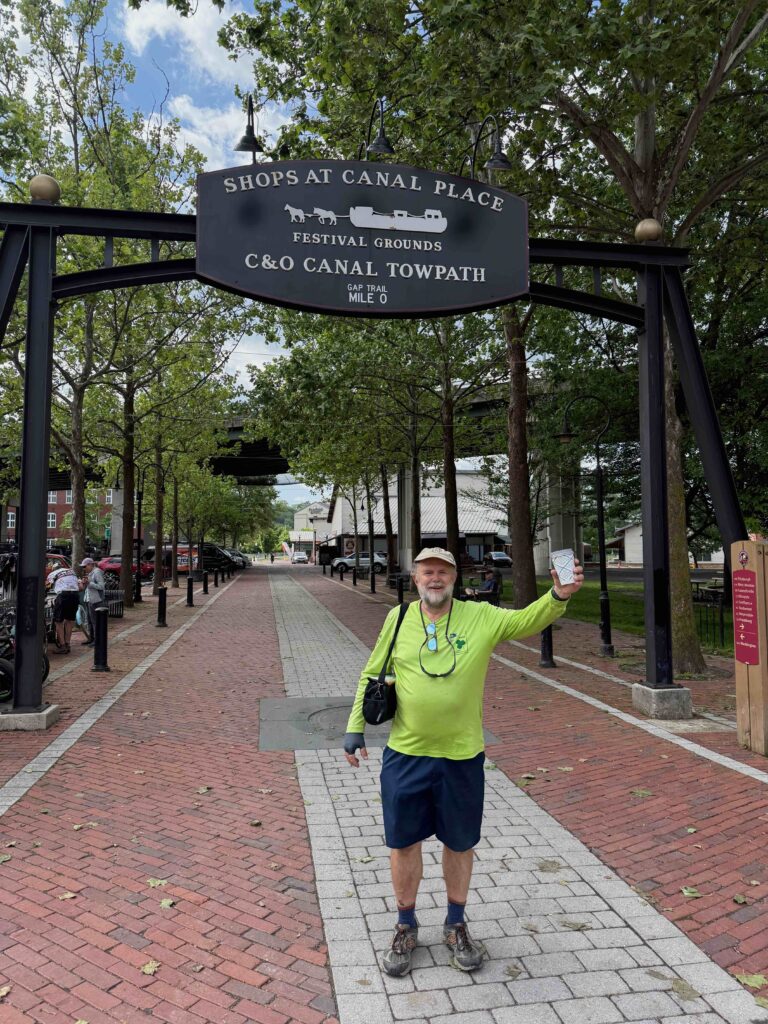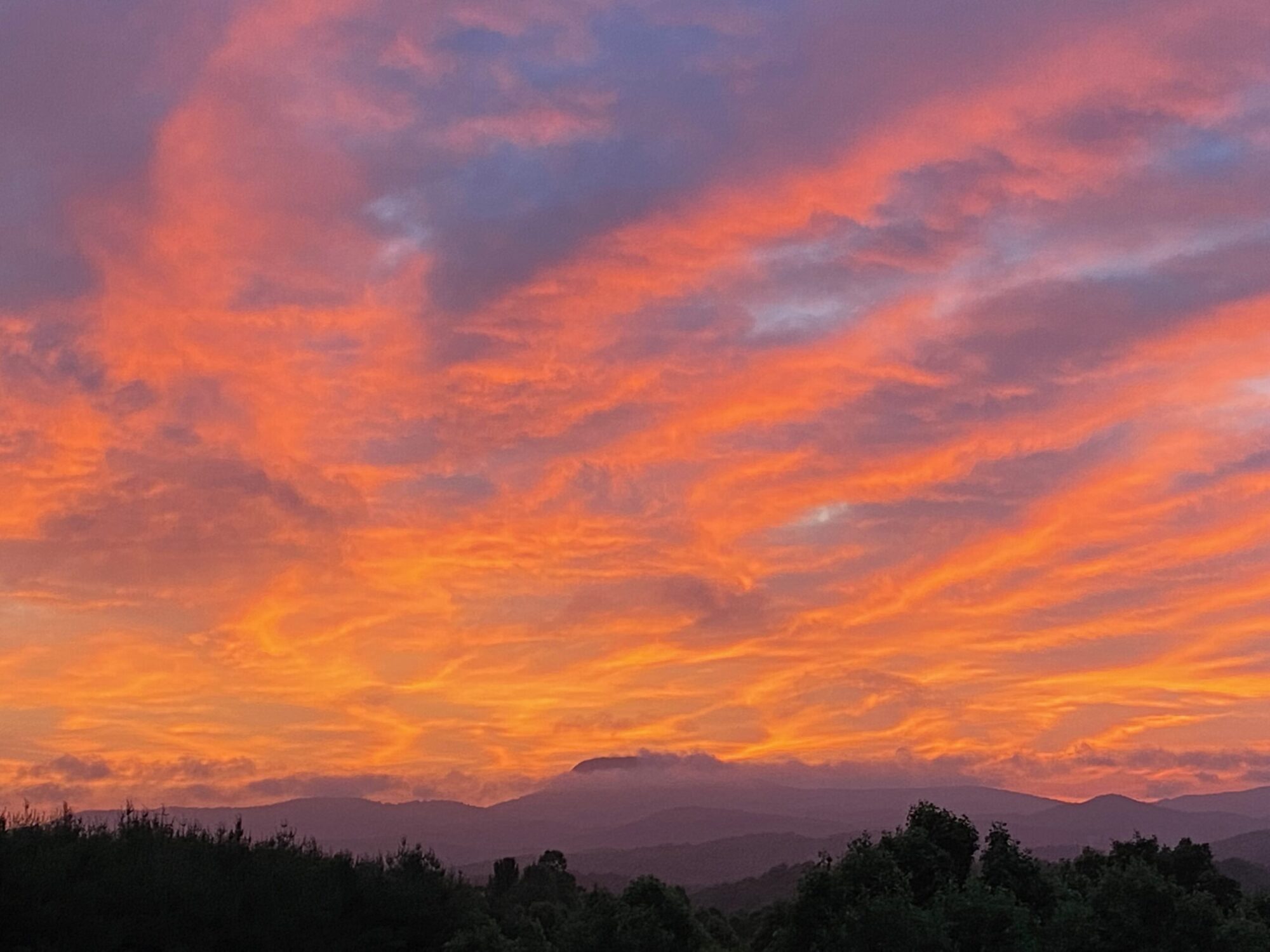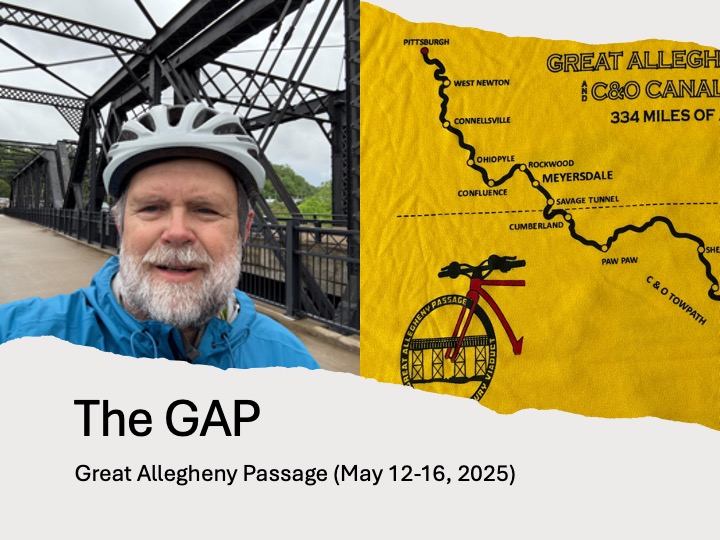“I was asleep. I had been told to wear ear plugs to block the train noise,” he said. “At 4 AM, I work up to my tent shaking and people yelling. At first, I couldn’t make it out, but then realized they were saying the water rising and I must get to get out.” This was the experience of another bicyclist along the Great Allegheny Passage. He had camped on the banks of the Youghiogheny River, just outside West Newton. He got up just in time to pull his tent and gear to higher ground. Then he joined in the effort to help others with the rising water.
I didn’t get his name. My guess is he was in his 40s and from York, Pennsylvania. We met him on Friday morning, at Meyersdale. He was heading out on his last day on the trail. He would complete the “GAP”, (the Great Allegheny Passage) that afternoon after a 24-mile downhill run. Later that day, as we ate lunch at an overlook just outside the Big Savage Tunnel, my brother recalled his positive attitude. Such an attitude pays off when confronted with challenges.
Day 1: Getting to Pittsburgh
Warren and I began our journey on Tuesday afternoon, when his brother-in-law Hitch dropped us off a block from “The Point” in Pittsburgh. This is the confluence of the Allegheny and Monongahela Rivers, where they form the Ohio River.
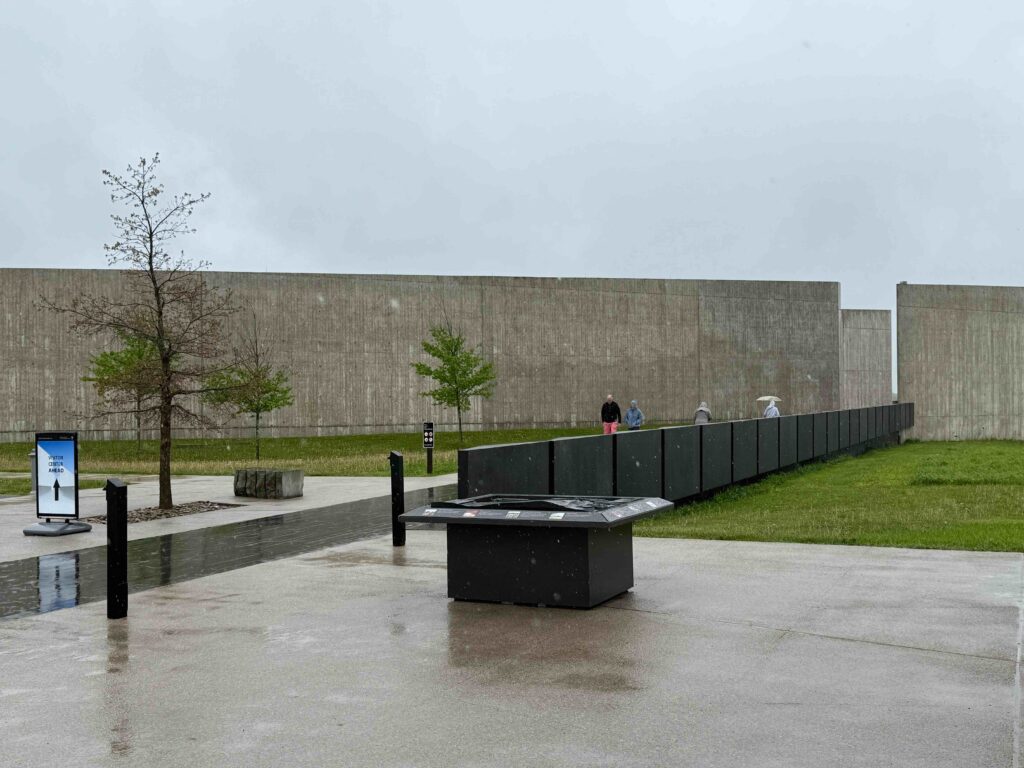
It had rain heavily for two days. On Monday, after planting the tomatoes I’d grown from seed in my garden, I’d drove in rain to Hancock, Maryland. The next morning, Warren and Hitch picked me up. I left my car at the Hancock Presbyterian Church. In the rain, we loaded my gear in my brother’s car and placed my bike next to his on this rack. We took the backroad, US 30, which had been the Lincoln Highway before the interstates, so that we could stop at the Flight 93 Memorial near Shanksville. The museum was sobering, but it rain too hard to do anything outside. Then, in Irwin, I introduced the two of them to a Western Pennsylvania stable, an Eat-n-Park Restaurant.
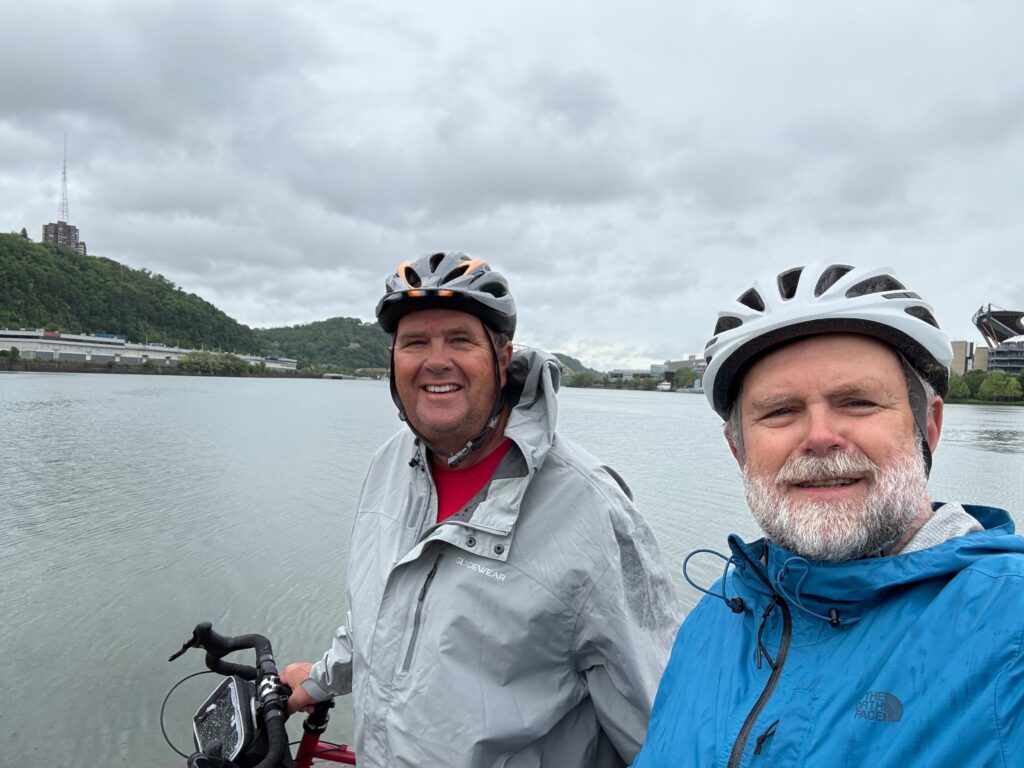
Thankfully, as we approached the city, the downpour weakened to a drizzle. Warren pulled the car over a block from Point State Park. We got our bikes off and loaded. Hitch took the keys to drive the car back to his home in Washington. Warren and I headed out to the Point. Looking over the city I called home for three years; I pointed out several landmarks to my brother. Of course, in the nearly 40 years since I moved to the Steel City, many things had changed. Three River Stadium was gone. Replacing it along the north side of the river was two new venues, one a football stadium for the Steelers and PNC Park, where the Pirates play.
Day 1: The Point to Homestead, 8 miles

The GAP runs along the east side of the Monongahela through downtown, until it crosses over to the west side of the river on the “Hot Metal Bridge.” When steel was still being made on the Southside and at the J&L plant just outside of Oakland (home of the University of Pittsburgh), this bridge was still in use. When I lived in Pittsburgh, the Southside had been converted to an upscale shopping district known as Station Square. J&L was still running but would close before I left the city. We continued along the river, stopping at a hotel in Homestead. We only rode 8 miles in a hour which included a lot of stops along the way.
Homestead
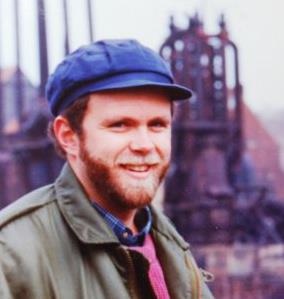
Homestead had been completely remade since I lived in Pittsburgh. While there, they began to tear down the huge US Steel plant, which ran for four miles along the river. The first book about the city I read after moving there was Thomas Bell’s Out of this Furnace. The novel, published in 1941, told the story of three generations of eastern Europeans who worked at the mills in Homestead and across the river in Braddock. I found myself making several trips to Homestead, especially after they started tearing down the mill. Today, where the mill once sat is a community of apartments, condos, hotels, restaurants, parks, and shopping. After arriving at the hotel, we explored the community on foot.
Day 2: Homestead to McKeesport, 51 miles
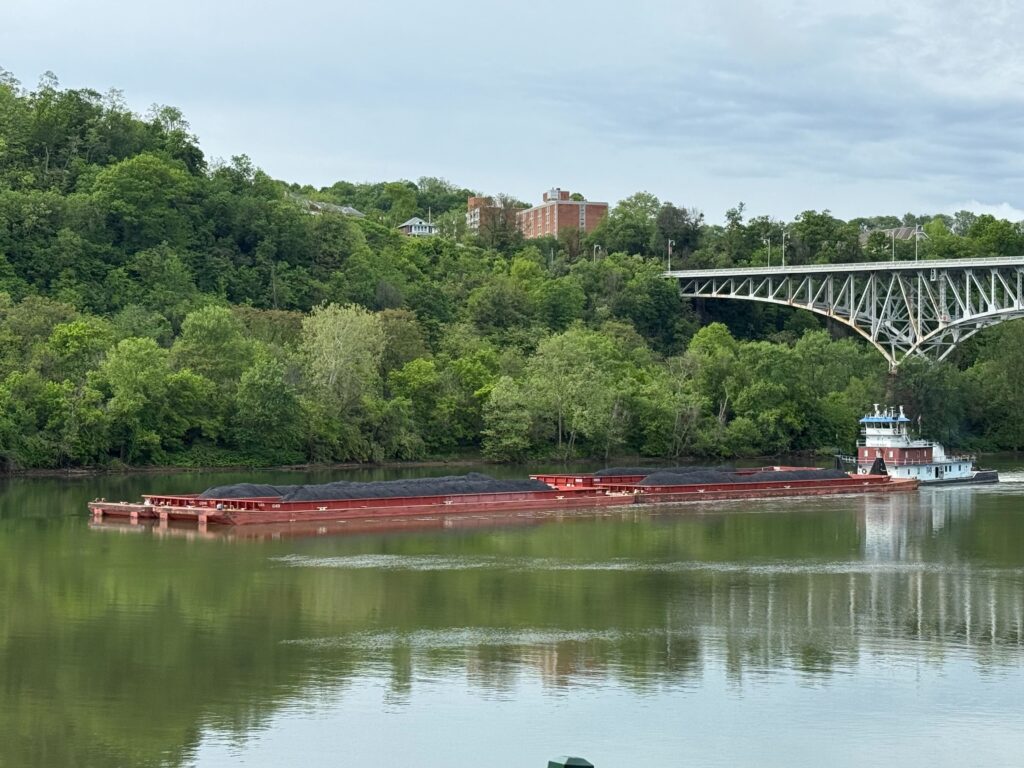
We left the hotel in Homestead at 7:45 AM. The remnants of steel mills were all around us with only one mill appearing to operate. Before McKeesport, we had a long detour as they resurfaced the trail. At McKeesport, we crossed over the Monongahela and began our climb alongside the Youghiogheny River. As we were leaving McKeesport, having traveled along some streets, my back tire went flat. Stopping, I discovered an inch and a half finishing nail through the tire and the tube. I replaced it with a fresh tube and after about 15 minutes we were again riding.
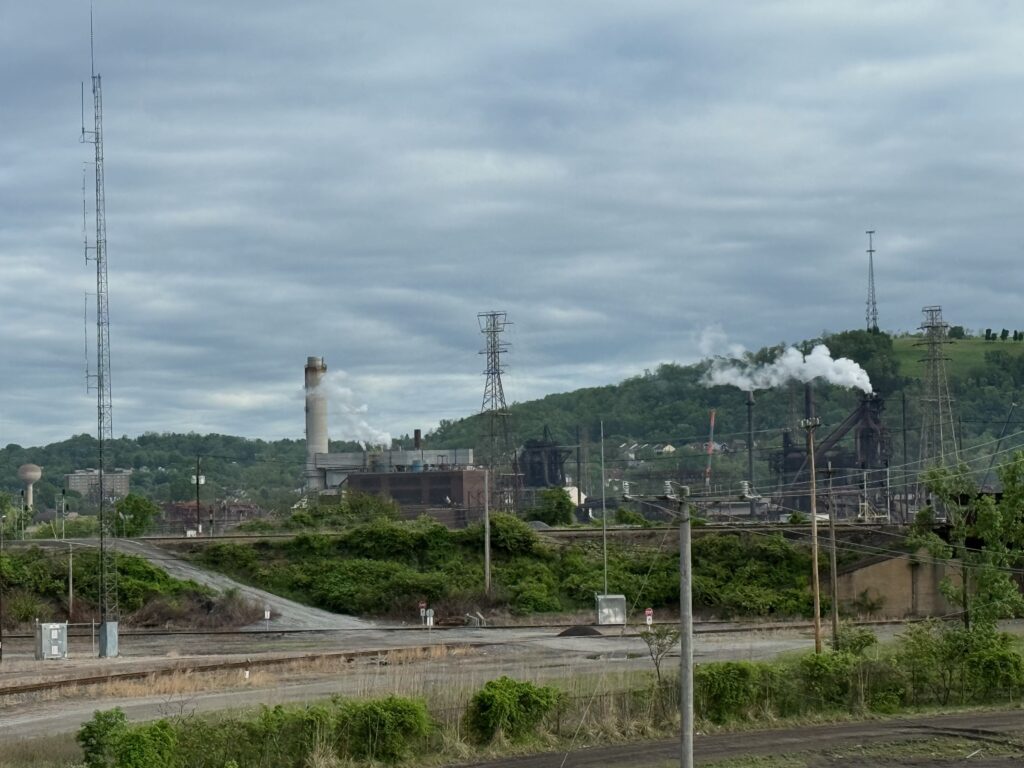
The trail along this section consisted of former industrial sites and some forest. With the river to our left, we occasionally would have a waterfall to our right. Often, these falls carried toxic waste from coal mines and left an orange sludge on the rocks.
Lunch in West Newton
At West Newton, we stopped at a bike shop where I picked up a new tube. I kept the old tube to repair so that I would have two tubes available. We’d been told of a good restaurant along the river, just behind the bike shop, but it was closed. The shop suggested we try Gary’s Chuckwagon, where for $15, I had a huge slab of a beer-battered fried cod (fish) on a homemade hoagie bun.
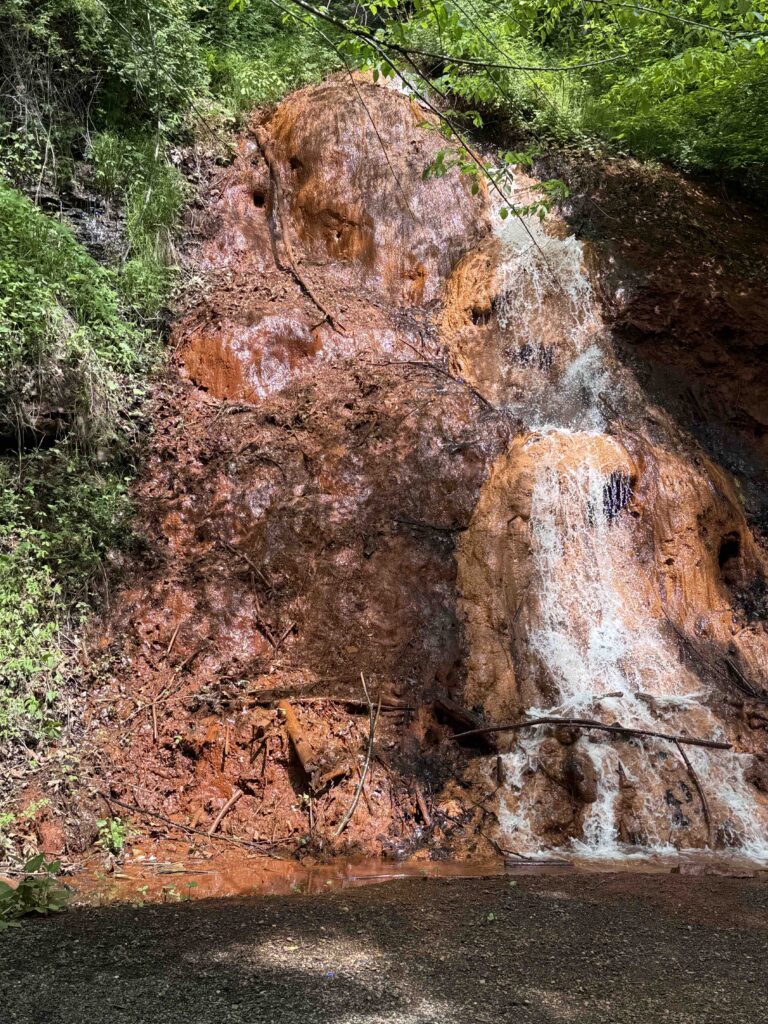
Coming out of West Newton, I spotted a possum. It appeared to have badly matted hair. When I got closer, I realized the matted mess of hair were younger possums getting a ride on mom. These weren’t small possums. They looked to be about half grown. I would have thought the mother would have told them it was time to start walking by themselves.
About eight miles from Connellsville, our evening destination, the skies opened. We took shelter for a while under an overpass with two other riders. When the rain subsided, we began to ride again, only to have another downpour. By the time we reached the hotel in Connellsville, we were both soaked, and our bikes were dirty from the mud. Thankfully, the Comfort Inn where we were staying had a wash station for bikes, which we used. They also had a room, which was locked at night, where we could store our bikes. That evening we ate at the River’s Edge Restaurant. I wasn’t overly hunger, so I had a bowl of shrimp bisque and a salad.
Day 3, Connellsville to Rockwood, 45 miles
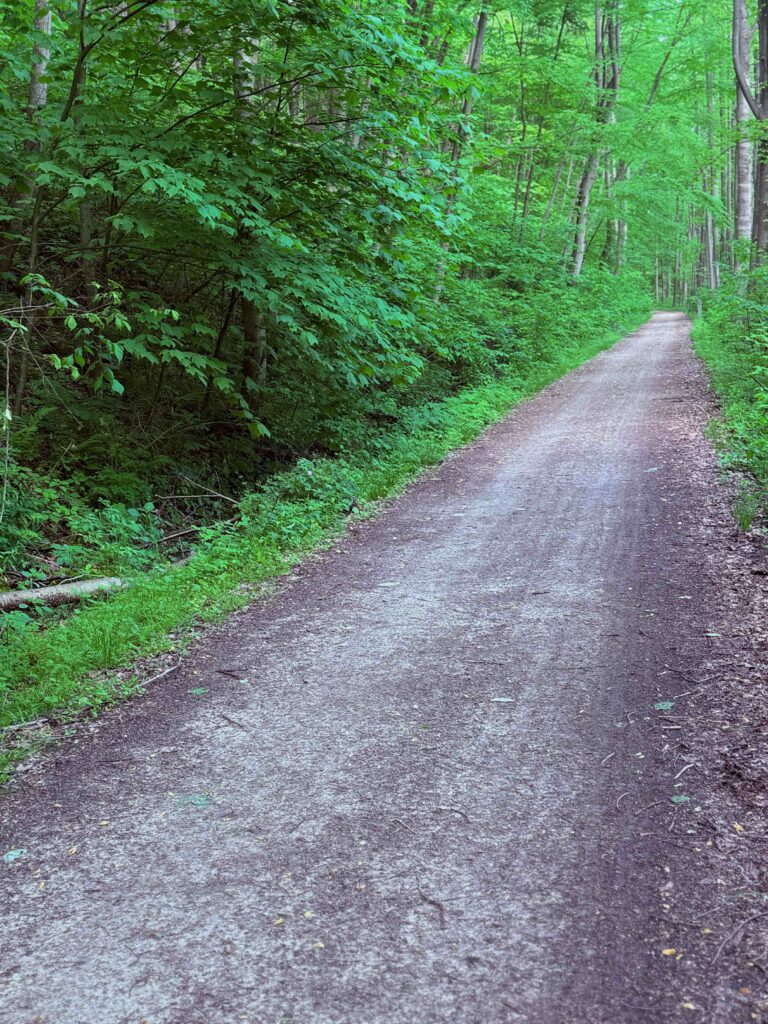
We left again at 8:15 in the morning. This was my favorite section as we left behind old industry and mostly peddled through woodlands with lovely stops at Ohiopyle, an old resort town that features some of America’s best whitewater. However, due to the high water levels, no one was kayak or rafting. We stopped at ate lunch in the park at Confluence. Warren had brought a couple of Underwood Chicken Salad cans and was wanting to rid himself of the extra weight. I grabbed an extra bagel at breakfast and used it to make a sandwich.

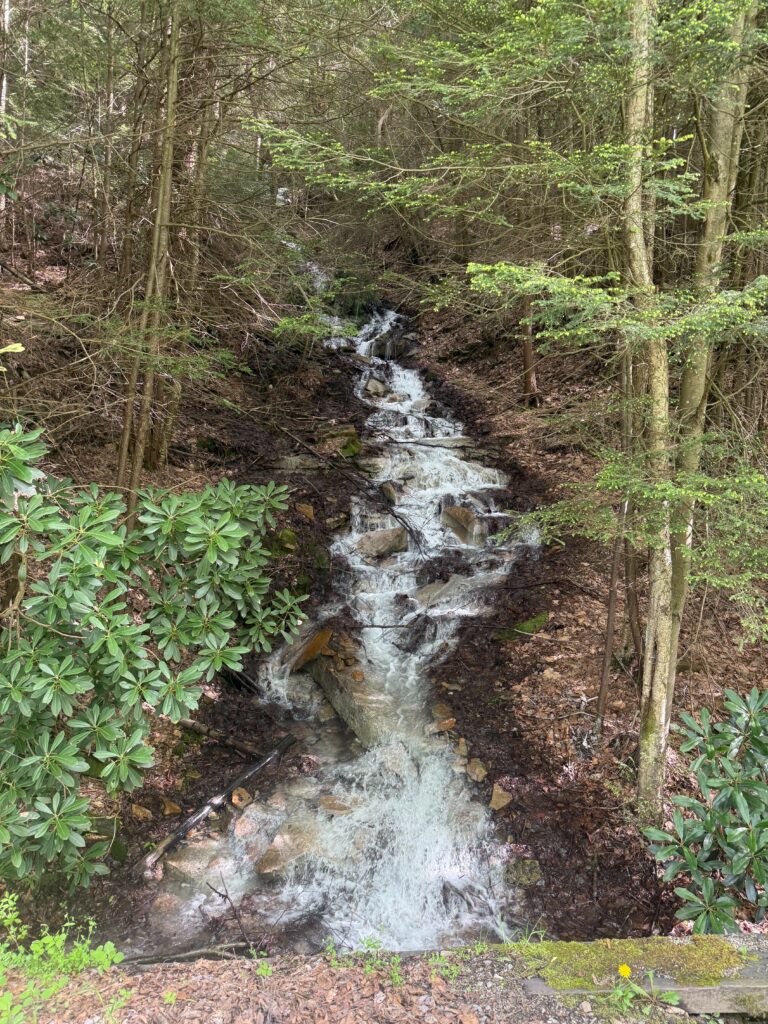
The trail became noticeable steeper, especially after Confluence, as we broke away from the Youghiogheny River and followed the Casselman River. But the bed was wider, probably because of requiring double tracks on this steep section. It was easy to ride double through much of this section. For some reason, my left Achilles tendon began to bother me the more I rode. As for animals, I saw several deer and a few garner snakes.
We were the only people staying at the Rockwood Trail House, a bed and breakfast in which the hosts lived elsewhere. Max, whom we’d met the day before, stayed by himself in another B&B. The old home had been magnificently restored. It was also well stocked with healthy breakfast makings including yogurt, multiple kinds of granola, fruits, boiled eggs, and breads. For dinner, we walked into town (about a half mile) and ate at the Rock City Bar and Café. It was your typical Western Pennsylvanian bar with cheap bottle beer ($2.50 each) and great burgers. I had a Rocket Burger, which included sautéed mushroom, peppers, onions with cheese sticks. Including the beer, my tab was $13.65.
Day 4, Rockwood to Cumberland, 43 miles
I woke up after a weird dream mixed with people from the church I served in Michigan with the church in which I grew up in North Carolina. The morning was humid. After eating fruit, granola, and yogurt for breakfast, we headed out. It felt like rain. We still had 19 miles of climbing, but the grade was less than it had been the day before. After an hour, we were in Meyersdale. Thankfully, the trail runs high above the town where there was a nice museum in the old depot. I purchased a GAP/C&O Canal shirt. The town had experienced bad flooding earlier in the week. The trail also became more rutted from the water that eroded the bed. It was at the museum that we met the guy who had been flooded out of his tent site earlier in the week.
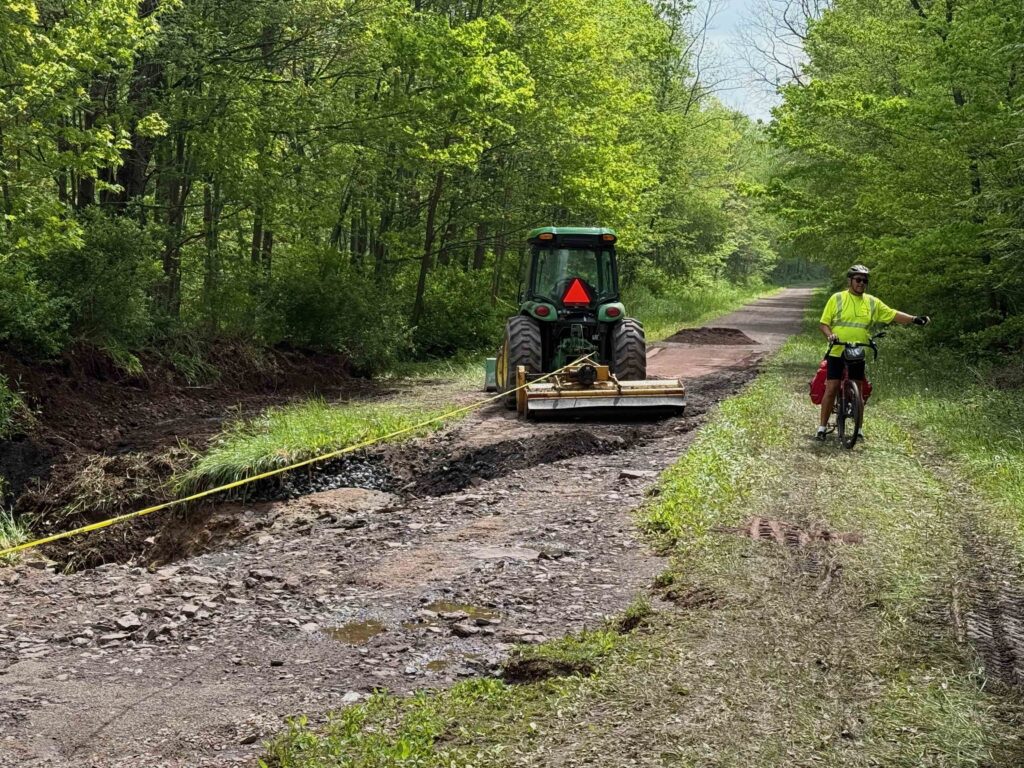
After Meyersville, we had another six miles of climbing as we made our way to the Eastern Continental Divide. Shortly afterwards, we passed through the Big Savage Tunnel. While I had a light for my handlebars, I didn’t reedit as we discovered the 3,294 feet tunnel had lights. Coming out of the tunnel on the south end, we were treated to a magnificent view of the mountains to our east. As we took photos of the tunnel, we spoke to a biker heading to Pittsburgh. He was riding a commuter bike with a metal basket on the front. He’d come from Washington and told of the flooding and long detours and carrying his bicycle through knee-depth water along the C&O. He hoped for our sake; things would be drying out. It wouldn’t.
Downhill from the Savage Tunnel

After the tunnel, we stopped for lunch. Eating tuna salad sandwiches, we could hear the wisp of windmills generating electricity from the ridge above the tunnel. While we still had a little over 20 miles to go, we felt as if we had completed the trail as it was downhill from here. A mile or less after the tunnel, we paused at the monument for the Mason Dixon line, which separates Pennsylvania from Maryland. Crossing over, we were officially back in the South!
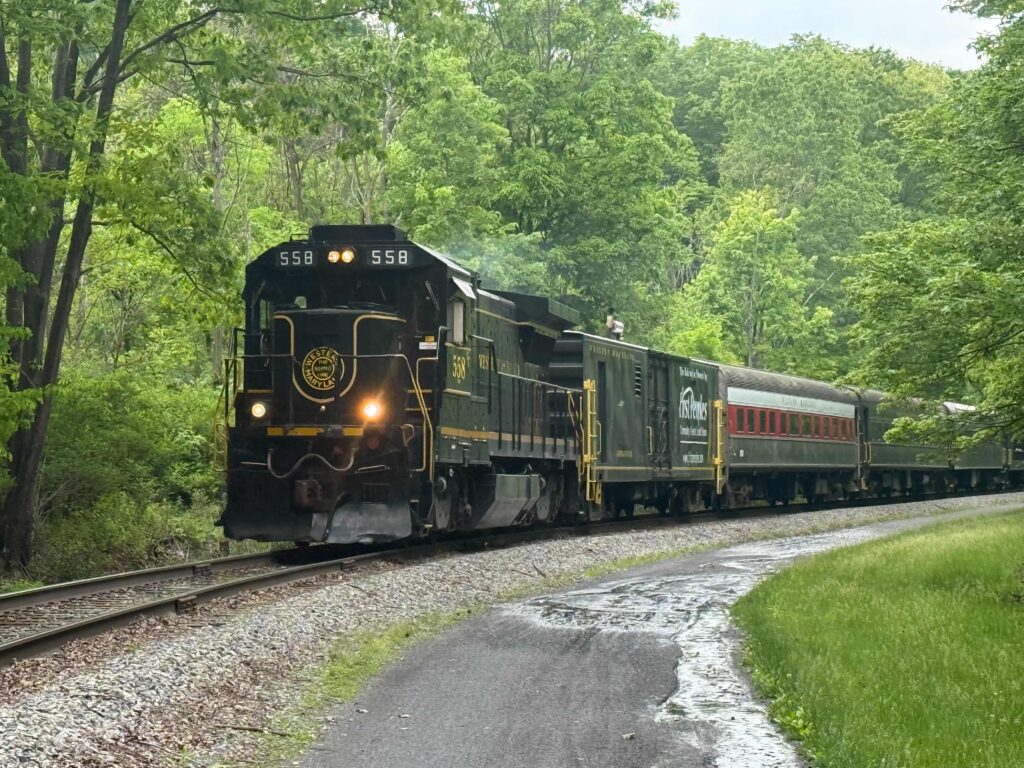
The GAP passes underneath the town of Frostburg. We talked of ice cream, but it required a climb to get into the town. Frostburg is a college town and on both sides of the town, we passed college students walking and running along the trail. About a mile south of Frost burg, I had another flat on my back tire. This time, I couldn’t find the cause. But the tube had a ¼ inch hole not far from the valve stem. One set of tracks of the Western Maryland still operate through this section and moments after having sat on the raised ballast to change my tube, a tourist train came down the tracks.
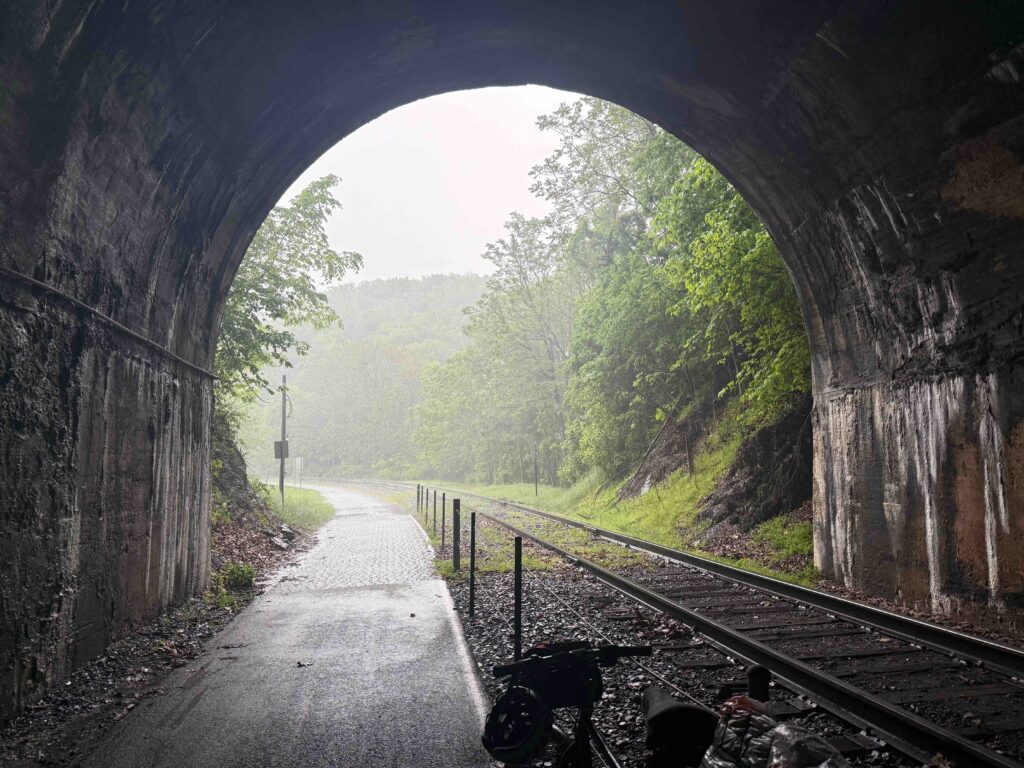
As the trail became steeper going down the hill, it also became more washed out. Instead of flying downhill, we had to control our speed on a roadbed that felt like a washboard. At places, the trail was so rough we walked the bikes. Clouds began to build, and thunder could be heard. We entered the 914-foot Brush Tunnel as the skies opened and waited out the storm inside. Another biker, who had ridden much of which had walked, joined us. The rocky and jarring path had caused him to lose both his light and his water bottles.
In Cumberland, at the end of the GAP
As the rain slowed, we again ventured out and rode all the way into Cumberland, arriving a little after 4 PM. We had hope to get there before the National Park Service office for the C&O Canal closed, but learned they work only till 4 PM. The rain and lightning had slowed us down and we just missed them. A maintenance employee for the park service came out and talked to us, confirming our fears. Parts of the trail were completely washed out and closed. We then went to a bike shop where we learned that the bypass to the C&O wasn’t a good option as it was a narrow windy road with semis traveling on it. We tentatively made plans for a shuttle in the morning.
Next, we headed to the Ramada Inn, where they had a room for bikes. After cleaning up, we headed out for dinner. Checking in as we were leaving was another biker who had passed us. He had continued along the C&O but came to place where he couldn’t go any further and didn’t want to ride the roadway. He came back to Cumberland and was planning to take the next day’s train to Pittsburgh.
We ate dinner at City Lights, a place that sounded a lot like a North Beach bookstore in San Francisco (and there’s another one in Iowa City). I had a Greek Salad with grilled chicken, which was delicious. After dinner, we walked around town, crossing a creek to see the Cumberland First Presbyterian Church, where I had once preached during my second year of seminary. We headed to bed early, not knowing what the next day would hold. At least, we’d completed the GAP.
Hopefully, I’ll write about the C&O experience next week.
